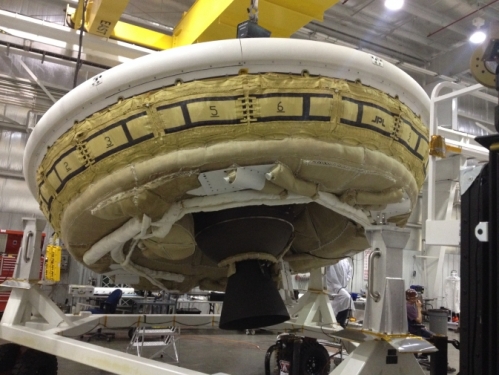
(Photo Credit: NASA/JPL)
A saucer-shaped vehicle, part of NASA’s Low-Density Supersonic Decelerator project (LDSD), is getting ready for its first test flight. The rocket-powered craft has now undergone final assembly at the U.S. Navy’s Pacific Missile Range Facility in Kauai, Hawaii and is preparing for lift off.
The craft’s experimental flight is designed to test NASA’s breakthrough technology that scientists hope will be used for future Mars missions, including those involving astronauts.
 (The craft in the clean room – Photo Credit: Susan Karlin)
(The craft in the clean room – Photo Credit: Susan Karlin)
In preparation for its June 3rd launch, the vehicle has begun three weeks of testing, simulations and rehearsals.
Mark Adler, project manager of the LDSD announced: “Our Supersonic Flight Dynamics Test Vehicle number 1 arrived at the Navy’s Pacific Missile Range Facility on April 17… since then we have been preparing it for flight. One of the last big assemblies occurred on April 30, when we mated the vehicle with its Star-48 booster rocket”.
The LDSD ‘s principal investigator from JPL, Ian Clark, states: “This first test is a true experimental flight test”. He explains “Our goal is to get this first-of-its-kind test vehicle to operate correctly at very high speeds and very high altitudes”
The vehicle will not blast off from the ground in the traditional way. A balloon will lift the test craft to an altitude of about 120,000 feet where it will then detach from the balloon. Its booster rocket will hopefully engage and carry it to 180,000 feet, accelerating the craft to Mach 4.

(Photo Credit: Susan Karlin)
Once high above the Pacific, the saucer will begin a series of automated tests to assess how its breakthrough technology is performing. Two components set to be tested are the Supersonic Inflatable Aerodynamic Decelerator (SIAD) and a large parachute called the Supersonic Disk Sail Parachute. These will hopefully deploy to ensure a safe landing.
The upper layers of our planet’s stratosphere contain similar properties to the thin atmosphere on Mars. Therefore the Low Density Supersonic Decelerator will reach 180,000 feet in order to replicate the conditions it would have to perform in on Mars.
Exploring experimental cutting-edge technology like LDSD is critical if NASA aims to successfully send larger payloads to Mars. They are also vital as they could pave the way for future human exploration and habitation. The saucer shaped craft is planned to deliver supplies and materials which would be needed for long-duration missions to our neighbor, the Red Planet.
The public will be able to watch a live video from the test flight as the vehicle will relay a feed to the ground. Although the resolution of the images might be low, it will hopefully show the craft dropping away from the high-altitude balloon and then travelling to the very edge of Earth’s stratosphere.
 (In position at the launch tower, awaiting attachment to its balloon – Photo Credit: NASA/JPL)
(In position at the launch tower, awaiting attachment to its balloon – Photo Credit: NASA/JPL)
Although no one knows if this first flight will be successful, the LDSD team expects to learn a great deal of information from the test, regardless of its outcome.
Clark states “We are pushing the envelope on what we know. We are accepting higher risk with these test flights than we would with a space mission…we will learn a great deal even if these tests, conducted here in Earth’s atmosphere at relatively low cost, fail to meet some of the mission objectives”.
65 years after the first Flying Saucer reports, finally a REAL one!!
No way! A saucer!?? I am just amazed, no idea NASA was experimenting with the saucer design. Thanks for the photos and story, I had no idea. Can’t wait to hear about the launch from balloon.